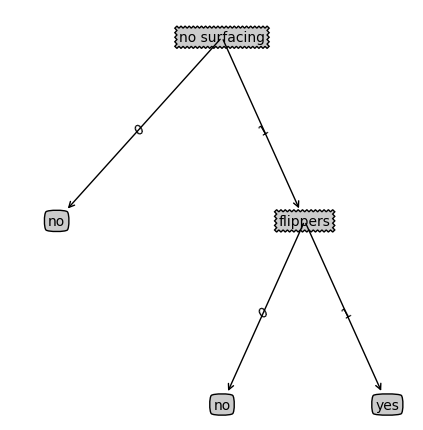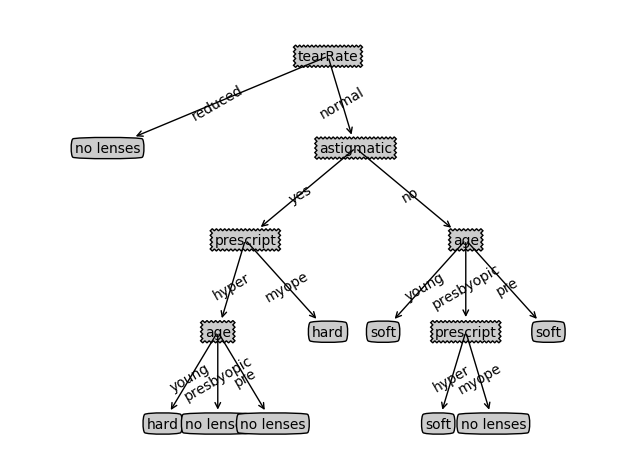决策树算法小结(一) ID3原理及代码实现
决策树是一种基本的分类与回归方法,称之为"树",是因为决策树模型呈树形结构。本小结主要讨论用于分类的决策树,那么决策树是如何从一大堆无序的数据特征中找出有序的规则,并构建决策树呢?
1 信息论知识
回答上面的问题,将一堆无序的数据变得更有序,一种方法是使用信息论度量信息。在划分数据前后,使用信息论量化度量信息的内容。在划分数据集前后,信息发生的变化称为信息增益,计算每个特征划分数据集获得的信息增益,获得信息增益最高的特征就是最好的选择。评测哪种数据划分方式是最好的数据划分前,先计算信息增益。
大家都知道一个事实,一件事发生的概率越小,它蕴含的信息量就越大。如果待分类的食物可能划分在多个分类中,则衡量信息量的表达式为:
其中\(p(x_{i})\)是选择该分类的概率。
信息熵是所有类别所有可能值保护的信息量的期望:
表示事件\(X\)发生的不确定度,\(n\)表示\(X\)的\(n\)种离散取值,也就是分类的数目。
2 决策树ID3算法
前面给出了一个事件(变量)X的熵,推广到多个事件的联合熵,给出事件X和Y的联合熵表达式: \(H(X,Y)=-\sum_{i=1}^{n}p(x_{i},y_{i})logp(x_{i},y_{i})\)
条件熵表达式:\(H(X|Y)=-\sum_{i=1}^{n}p(x_{i},y_{i})logp(x_{i}|y_{i})=\sum_{j=1}^{n}p(y_{j})H(X|y_{j})\) 度量在Y已知情况下X剩下的不确定性
另外,\(H(X)-H(X|Y)\) 度量X在Y已知情况下不确定性减少的程度,信息论中称为互信息\(I(X,Y)\),在决策树ID3算法中称为信息增益,ID3算法中用信息增益衡量使用当前特征
对样本划分的效果,其中信息增益越大,表示当前特征更适合用来分类。
信息增益的算法
输入: 训练数据集\(D\)和特征\(A\)
输出: 特征\(A\)对训练数据集\(D\)的信息增益\(g(D,A)\)
step1: 计算数据集\(D\)的熵\(H(D)\) $$H(D)=-\sum_{k=1}^{K}\frac{|C_{k}|}{|D|}log_{2}\frac{|C_{k}|}{|D|}$$ 其中\(K\)表示类别的个数,\(|C_{k}|\)表示属于类\(C_{k}\)的个数,\(|D|\)表示样本个数
step2: 计算特征\(A\)对数据集\(D\)的条件熵\(H(D|A)\) $$H(D|A)=\sum_{i=1}{n}\frac{|D_{i}|}{|D|}H(D_{i})=-\sum_{i=1}\frac{|D_{i}|}{|D|}\sum_{k=1}^{K}\frac{|D_{ik}|}{|D_{i}|}log_{2}\frac{|D_{ik}|}{|D_{i}|}$$ 其中\(n\)表示特征\(A\)取值的个数,特征\(A\)取值将数据集\(D\)划分为\(n\)个子集$D_{1},D_{2},\cdots,D_{n} $ ,\(|D_{i}|\) 表示\(D_{i}\)样本的个数, \(K\)表示特征\(A\)的样本输出类别的个数,\(D_{ik}\)表示子集\(D_{i}\)中属于类\(C_{k}\)的个数,\(|D_{ik}|\)表示\(D_{ik}\)的样本个数
step3: 计算信息增益 $$g(D,A)=H(D)-H(D|A)$$
举例,给表中所给的训练数据集\(D\),根据信息增益准则选择最优特征
首先计算熵据集\(D\)的熵\(H(D)\) $$H(D)=-\frac{9}{15}log_{2}\frac{9}{15}-\frac{6}{15}log_{2}\frac{6}{15}=0.971$$ 数据集\(D\)有15个样本,输出类别只有"是"和"否"两类, 其中9个输出"是",6个输出"否"。
然后计算各特征对数据集\(D\)的信息增益。分别以\(A_{1}\),\(A_{2}\),\(A_{3}\),\(A_{4}\)表示年龄 有工作 有自己的房子和信贷情况4个特征

最后,比较各特征的信息增益值,由于特征\(A_{3}\)的信息增益值最大,因此选择特征\(A_{3}\)作为最优特征。
ID3算法核心是在决策树各个结点上用信息增益准则选择特征,递归地构建决策树,相当于用极大似然法进行概率模型的选择。
决策树ID3算法
输入: 训练数据集\(D\),特征集\(A\),阈值$\varepsilon $;
输出: 决策树\(T\)
step1 若\(D\)中所有实例属于同一类\(C_{k}\),则\(T\)为单结点树,并将类\(C_{k}\)作为该结点的类标记,返回\(T\);
step2 若\(A=\Phi\),则\(T\)为单结点树,并将\(D\)中实例数最大的类\(C_{k}\)作为该结点的类标记,返回\(T\);
step3 否则计算特征集\(A\)中各特征对\(D\)的信息增益,选择信息增益最大的特征\(A_{g}\);
step4 如果\(A_{g}\)的信息增益小于阈值\(\varepsilon\),则置\(T\)为单结点树,并将\(D\)中实例数最大的类\(C_{k}\)作为该结点的类标记,返回\(T\);
step5 否则,对\(A_{g}\)的每一个取值\(A_{gi}\)将对应的样本输出\(D\)分成不同的类别\(D_{i}\),每个类别产生一个子节点,对应特征值是\(A_{gi}\),返回增加了结点的树;
step6 对所有的子结点,以\(D_{i}\)为训练集,以\(A-{A_{g}}\)为特征集,递归调用(1)-(5),得到子树\(T_{i}\),返回\(T_{i}\).
3 决策树代码实现
计算给定数据集的香农熵--使用熵划分数据集
from math import log
def calcShannonEnt(dataSet):
numEntries = len(dataSet) #计算数据集中实例的总数
labelCounts = {} #创建数据字典 其键值是最后一列的数值
for featVec in dataSet: #为所有可能分类创建字典
currentLabel = featVec[-1]
if currentLabel not in labelCounts.keys():
labelCounts[currentLabel] = 0 #每个键值记录当前类别出现的次数
labelCounts[currentLabel] += 1
shannonEnt = 0.0
for key in labelCounts:
prob = float(labelCounts[key])/numEntries #使用所有类标签的发生频率计算类别出现的概率
shannonEnt -= prob*log(prob, 2) #以2为底求对数 统计所有类标签发生的次数
return shannonEnt
#创建数据集和标签
def createDataSet():
dataSet = [[1, 1,'yes'],
[1, 1, 'yes'],
[1, 0, 'no'],
[0, 1, 'no'],
[0, 1, 'no']]
labels = ['no surfacing', 'flippers']
return dataSet, labels
#运行效果
myDat, labels = createDataSet()
print(myDat, labels)
#输出
[[1, 1, 'yes'], [1, 1, 'yes'], [1, 0, 'no'], [0, 1, 'no'], [0, 1, 'no']]
['no surfacing', 'flippers']
print(calcShannonEnt(myDat))
#输出
0.9709505944546686 #熵越高,则混合的数据也越多
在数据集中添加更多的分类,观察熵是如何变化的。增加第三个名为maybe的分类,测试熵的变化
myDat, labels = createDataSet()
myDat[0][-1] = 'maybe'
print(myDat, labels)
#输出
[[1, 1, 'maybe'], [1, 1, 'yes'], [1, 0, 'no'], [0, 1, 'no'], [0, 1, 'no']]
['no surfacing', 'flippers']
print(calcShannonEnt(myDat))
#输出
1.3709505944546687 #得到熵 就可以按照获取最大信息增益的方法划分数据集
前面学习了如何度量数据集的无序程度,分类算法除了需要测量信息熵,还需要划分数据集,度量划分数据集的熵,以便判断当前是否正确地划分了数据集。对每个特征划分数据集的结果计算一次信息熵,然后判断按照哪个特征划分数据集是最好的划分方式。
#按照给定特征划分数据集
def splitDataSet(dataSet, axis, value): #三个参数:待划分数据集 划分数据集的特征 需要返回的特征的值
retDataSet = [] #创建新的list对象 由于该代码函数在同一数据集上被调用多次 为了不修改原始数据集创建了新的列表对象
for featVec in dataSet: #遍历数据集中的每个元素 符合要求的值将其添加到新创建的列表中(注:数据集这个列表中的各个元素也是列表)
if featVec[axis] == value: #抽取符合条件的数据 即按照某个特征划分数据集时 需要把所有符合要求的元素抽取出来
reducedFeatVec = featVec[:axis]
reducedFeatVec.extend(featVec[axis+1:])
retDataSet.append(reducedFeatVec)
return retDataSet
#测试splitDataSet()
myDat, labels = createDataSet()
print(myDat)
#输出
[[1, 1, 'yes'], [1, 1, 'yes'], [1, 0, 'no'], [0, 1, 'no'], [0, 1, 'no']]
print(splitDataSet(myDat,0,1))
#输出
[[1, 'yes'], [1, 'yes'], [0, 'no']]
print(splitDataSet(myDat,0,0))
#输出
[[1, 'no'], [1, 'no']]
遍历整个数据集,循环计算香农熵和splitDataSet()函数,找到最好的特征划分方式。熵计算将会告诉我们如何划分数据集是最好的数据组织方式。
#选择最好的数据集划分方式—该函数实现选取特征 划分数据集 计算出最好的划分数据集的特征
def chooseBestFeatureToSplit(dataSet):
numFeatures = len(dataSet[0]) - 1 #判定当前数据集包含多少特征属性
baseEntroy = calcShannonEnt(dataSet) #计算整个数据集的原始香农熵 用于与划分完之后的数据集计算的熵值进行比较
bestInfoGain = 0.0
bestFeature = -1
for i in range(numFeatures): #遍历数据集中的所有特征
featureList = [example[i] for example in dataSet] #使用列表推到创建新的列表 将数据中所有第i个特征值写入这个新list中
uniqueVals = set(featureList) #得到唯一的分类标签列表
newEntropy = 0.0
for value in uniqueVals: #计算每种划分方式的信息熵 遍历当前特征中的所有唯一属性值 对每个特征划分一次数据集
subDataSet = splitDataSet(dataSet, i, value)
prob = len(subDataSet)/float(len(dataSet)) #计算数据集的新熵值
newEntropy += prob*calcShannonEnt(subDataSet) #对所有唯一特征值得到的熵求和
infoGain = baseEntroy - newEntropy #信息增益是熵的减少或者是数据无序度的减少
if (infoGain > bestInfoGain): #计算最好的信息增益 比较所有特征中的信息增益
bestInfoGain = infoGain
bestFeature = i
return bestFeature #返回最好特征划分的索引值
#测试
myDat, labels = createDataSet()
print(chooseBestFeatureToSplit(myDat))
#输出 第0个特征是最好的用于划分数据集的特征
0
print(myDat)
#输出
[[1, 1, 'yes'], [1, 1, 'yes'], [1, 0, 'no'], [0, 1, 'no'], [0, 1, 'no']]
介绍了如何度量数据集的信息熵,如何有效地划分数据集,下面将介绍如何将这些函数功能放在一起,构建决策树。
递归构建决策树
#采用多数表决的方法决定叶子节点的分类
import operator
def majorityCnt(classList): #classList分类名称的列表
classCount = {} #创建键值为classList中唯一值的数据字典 字典对象存储classList中每个类标签出现的频率
for vote in classList:
if vote not in classCount.keys():
classCount[vote] = 0
classCount[vote] += 1
sortedClassCount = sorted(classCount.items(),key=operator.itemgetter(1),reverse=True) #operator操作键值排序字典 降序排序
return sortedClassCount[0][0] #返回出现次数最多的分类名称
#创建树的函数代码
def createTree(dataSet, labels):
classList = [example[-1] for example in dataSet] #classList列表 包含数据集的所有类标签
if classList.count(classList[0]) == len(classList): #类别完全相同则停止划分 递归函数的第一个停止条件 所有的类标签完全相同
return classList[0] #直接返回该类标签
if len(dataSet[0]) == 1: #遍历完所有特征时返回出现次数最多的 递归函数的第二个停止条件 使用完所有特征仍不能将数据集划分成仅包含唯一类别的分组
return majorityCnt(classList) #该停止条件无法返回唯一的类标签 这里返回出现次数最多的类别
bestFeat = chooseBestFeatureToSplit(dataSet)
bestFeatLabel = labels[bestFeat]
myTree = {bestFeatLabel: {}} #创建树 使用字典类型存储树的所有信息
del (labels[bestFeat])
featValues = [example[bestFeat] for example in dataSet] #得到列表包含的所有属性值 遍历当前选择特征包含的所有属性值
uniqueVals = set(featValues)
for value in uniqueVals:
subLabels = labels[:] #复制类标签 确保每次调用createTree()时不改变原始列表的内容
myTree[bestFeatLabel][value] = createTree(splitDataSet(dataSet, bestFeat, value),subLabels) #在每个数据集划分上递归调用createTree()得到的返回值插入到字典myTree
return myTree
#测试
myDat, labels = createDataSet()
myTree = createTree(myDat, labels)
print(myTree)
#输出
{'no surfacing': {0: 'no', 1: {'flippers': {0: 'no', 1: 'yes'}}}}
测试算法:使用决策树执行分类
def classify(inputTree,featLabels,testVec):
firstStr = inputTree.keys()[0]
secondDict = inputTree[firstStr]
featIndex = featLabels.index(firstStr)
key = testVec[featIndex]
valueOfFeat = secondDict[key]
if isinstance(valueOfFeat, dict):
classLabel = classify(valueOfFeat, featLabels, testVec)
else: classLabel = valueOfFeat
return classLabel
绘图部分
''' Created on Oct 14, 2010@author: Peter Harrington
'''
import matplotlib.pyplot as pltdecisionNode = dict(boxstyle="sawtooth", fc="0.8")
leafNode = dict(boxstyle="round4", fc="0.8")
arrow_args = dict(arrowstyle="<-")def getNumLeafs(myTree):
numLeafs = 0
firstStr = myTree.keys()[0]
secondDict = myTree[firstStr]
for key in secondDict.keys():
if type(secondDict[key]).name=='dict':#test to see if the nodes are dictonaires, if not they are leaf nodes
numLeafs += getNumLeafs(secondDict[key])
else: numLeafs +=1
return numLeafsdef getTreeDepth(myTree):
maxDepth = 0
firstStr = myTree.keys()[0]
secondDict = myTree[firstStr]
for key in secondDict.keys():
if type(secondDict[key]).name=='dict':#test to see if the nodes are dictonaires, if not they are leaf nodes
thisDepth = 1 + getTreeDepth(secondDict[key])
else: thisDepth = 1
if thisDepth > maxDepth: maxDepth = thisDepth
return maxDepthdef plotNode(nodeTxt, centerPt, parentPt, nodeType):
createPlot.ax1.annotate(nodeTxt, xy=parentPt, xycoords='axes fraction',
xytext=centerPt, textcoords='axes fraction',
va="center", ha="center", bbox=nodeType, arrowprops=arrow_args )def plotMidText(cntrPt, parentPt, txtString):
xMid = (parentPt[0]-cntrPt[0])/2.0 + cntrPt[0]
yMid = (parentPt[1]-cntrPt[1])/2.0 + cntrPt[1]
createPlot.ax1.text(xMid, yMid, txtString, va="center", ha="center", rotation=30)def plotTree(myTree, parentPt, nodeTxt):#if the first key tells you what feat was split on
numLeafs = getNumLeafs(myTree) #this determines the x width of this tree
depth = getTreeDepth(myTree)
firstStr = myTree.keys()[0] #the text label for this node should be this
cntrPt = (plotTree.xOff + (1.0 + float(numLeafs))/2.0/plotTree.totalW, plotTree.yOff)
plotMidText(cntrPt, parentPt, nodeTxt)
plotNode(firstStr, cntrPt, parentPt, decisionNode)
secondDict = myTree[firstStr]
plotTree.yOff = plotTree.yOff - 1.0/plotTree.totalD
for key in secondDict.keys():
if type(secondDict[key]).name=='dict':#test to see if the nodes are dictonaires, if not they are leaf nodes
plotTree(secondDict[key],cntrPt,str(key)) #recursion
else: #it's a leaf node print the leaf node
plotTree.xOff = plotTree.xOff + 1.0/plotTree.totalW
plotNode(secondDict[key], (plotTree.xOff, plotTree.yOff), cntrPt, leafNode)
plotMidText((plotTree.xOff, plotTree.yOff), cntrPt, str(key))
plotTree.yOff = plotTree.yOff + 1.0/plotTree.totalDif you do get a dictonary you know it's a tree, and the first element will be another dict
def createPlot(inTree):
fig = plt.figure(1, facecolor='white')
fig.clf()
axprops = dict(xticks=[], yticks=[])
createPlot.ax1 = plt.subplot(111, frameon=False, **axprops) #no ticks
#createPlot.ax1 = plt.subplot(111, frameon=False) #ticks for demo puropses
plotTree.totalW = float(getNumLeafs(inTree))
plotTree.totalD = float(getTreeDepth(inTree))
plotTree.xOff = -0.5/plotTree.totalW; plotTree.yOff = 1.0;
plotTree(inTree, (0.5,1.0), '')
plt.show()def createPlot():
fig = plt.figure(1, facecolor='white')
fig.clf()
createPlot.ax1 = plt.subplot(111, frameon=False) #ticks for demo puropses
plotNode('a decision node', (0.5, 0.1), (0.1, 0.5), decisionNode)
plotNode('a leaf node', (0.8, 0.1), (0.3, 0.8), leafNode)
plt.show()
def retrieveTree(i):
listOfTrees =[{'no surfacing': {0: 'no', 1: {'flippers': {0: 'no', 1: 'yes'}}}},
{'no surfacing': {0: 'no', 1: {'flippers': {0: {'head': {0: 'no', 1: 'yes'}}, 1: 'no'}}}}
]
return listOfTrees[i]createPlot(thisTree)
import treePlotter
myDat, labels = createDataSet()
print(labels)
#输出
['no surfacing', 'flippers']
myTree = treePlotter.retrieveTree(0)
print(myTree)
#输出
{'no surfacing': {0: 'no', 1: {'flippers': {0: 'no', 1: 'yes'}}}}
print(classify(myTree, labels, [1, 0]))
#输出
'no'
print(classify(myTree, labels, [1, 1]))
#输出
'yes'
使用算法:决策树的存储
#使用pickle模块存储决策树
def storeTree(inputTree,filename):
import pickle
fw = open(filename,'wb')
pickle.dump(inputTree,fw)
fw.close()
def grabTree(filename):
import pickle
fr = open(filename, 'rb')
return pickle.load(fr)
storeTree(myTree, 'classifierStorage.txt')
print(grabTree('classifierStorage.txt'))
#输出
{'no surfacing': {0: 'no', 1: {'flippers': {0: 'no', 1: 'yes'}}}}
测试绘制决策树图的函数:
>>> import imp
>>> import trees
>>> imp.reload(trees)
<module 'trees' from 'D:\\Python\\Mechine_learning\\Tree\\trees.py'>
>>> import treePlotter
>>> myTree = treePlotter.retrieveTree(0)
>>> treePlotter.createPlot(myTree)

4 使用决策树预测隐形眼镜类型
import treePlotter
fr = open('lenses.txt')
lenses = [inst.strip().split('\t') for inst in fr.readlines()]
lensesLabels = ['age', 'prescript', 'astigmatic', 'tearRate']
lensesTree = createTree(lenses, lensesLabels)
print(lensesTree)
#输出
{'tearRate': {'reduced': 'no lenses', 'normal': {'astigmatic': {'no': {'age': {'young': 'soft', 'pre': 'soft', 'presbyopic': {'prescript': {'myope': 'no lenses', 'hyper': 'soft'}}}}, 'yes': {'prescript': {'myope': 'hard', 'hyper': {'age': {'young': 'hard', 'pre': 'no lenses', 'presbyopic': 'no lenses'}}}}}}}}
treePlotter.createPlot(lensesTree)
由ID3算法产生的决策树:

4 ID3算法总结
缺点:信息增益偏向取值较多的特征
原因:当特征的取值较多时,根据此特征划分更容易得到纯度更高的子集,因此划分之后的熵更低,由于划分前的熵是一定的,因此信息增益更大,因此信息增益比较 偏向取值较多的特征。
参考:统计学习方法 机器学习实战 决策树算法原理






 浙公网安备 33010602011771号
浙公网安备 33010602011771号